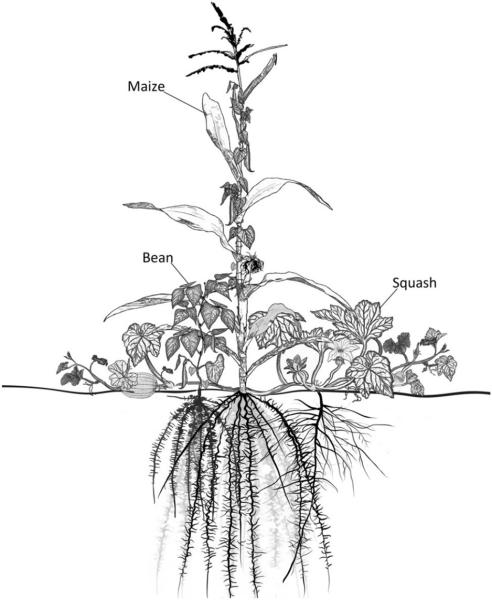
Be it fruits, vegetables or any other crops, pests have been foe to our agricultural production since ages. Although earliest record of insect pest control dates back to 2500 BC, the measures have never been the same. Pest management is consistently varying and albeit scientists have now succeeded in genetically engineered crops for pest regulation, usage of chemically synthesized pesticides is still prevalent among the farmers. Farmers have been using these pesticides at the expense of high prices, ecological well-being, consumers’ health and not to mention their own safety, while applying these detrimental chemicals on their crops. But what if we were told that nature has all the answers humankinds have been seeking for combating pests? Yes, you heard it right! A simple change in cropping pattern or a companion plant could be more than enough to keep pests away from damaging your crops. So, if you are questing for environmentally sound approach to manage and control pests, you will fall in love with the charm of intercropping.
Intercropping is the practice of planting various crops in the same field. Intercropping can take place in a variety of spatial arrangements, including mixed intercropping, where a variety of crops are planted in a row together or disregarding the row and the row intercropping, which involves growing several crops in rows that alternate. Depending on the intercrop’s intended use for the farming operation, intercropping system designs might vary significantly. The advantages of intercropping include greater productivity, a more balanced distribution of resources, decreased risk to the farm, and weed and insect pest control. There are different mechanisms of intercropping that can be employed for insect pest management.
1.Trap cropping: Trap cropping is a method that involves an attractant crop that is grown close to the major crop. Insects are attracted to the plant that is used as a trap crop because it is more appealing to them than the major crop. There are many effective instances of trap cropping. Mexican bean beetles can be controlled in soyabeans by using snap beans as trap crops. Similarly, Lygus has been lured away from main crop plantings of cotton and strawberries using alfalfa as a trap crop. Collard greens have been used as a trap crop in Florida to curb infestations of diamondback moth larvae in cabbage
2.Repellent intercrops: The control of insect pests can also be accomplished by using an intercrop with a repellent effect which averts the insect from its host crop. Volatile oils found in aromatic plants can disrupt host plant localization, feeding, distribution, and mating, which reduces pest abundance. Additionally, chemical properties found in particular intercrops have the ability to repel or deter pest insects. For example, it has been proven that herbs like basil planted with tomatoes deter thrips and tomato hornworms. Allium plants have been found to have repellent effects on a range of insects such as moths, mites, and aphids. Furthermore, a range of companion plants such as sage, rosemary, thyme, mint, chamomile, celery and tomatoes have been found to have pest-repelling effect against pests of Brassica crops.
3.Push-pull cropping: Insect pest management can be achieved by combining repellent crops and attractant crops which is known as push-pull cropping. Insects are attracted to the attractant crop, which serves as the “pull,” and are deterred by the repellent crop, which serves as the “push.” The push-pull technique, which was created in Africa, guards corn against stem-boring moth larvae by planting a border of Napier grass, which is more alluring to the moths, and Desmodium, which is a repellent legume, in between the rows of corn.
4.Masking intercrops: Some companion plants may exude volatiles that conceal the scents of the host plant, making the host plant difficult to locate. For instance, when host plants were bounded by a wide range of plants such as spurrey, peas, rye-grass or clover, host placement by the cabbage root fly was interrupted. Furthermore, companion plants have also been observed to change the chemical profile of the major crop. Several companion plants can directly influence adjoining plants by chemicals absorbed through its roots. African marigolds (Tagetes spp.), for example, produce root exudates that can be absorbed by nearby plants, which may assist to explain claims of decreased pest populations when African marigolds are present.
5.Physically blocking intercrops: Certain intercrops can conceal or obstruct host plants both physically and optically. Height of intercrops can play pivotal role in suppressing pests. For instance, dill has been planted as a vegetative barrier to impede pest motion in organic farming and maize have been planted to shield beans from pest attack. Sunflowers, sorghum, sesame, and pearl millet are among the companion plants that are frequently advised as physical barriers. According to the “appropriate/inappropriate landing” theory, host plant detection may be hampered by green surfaces around host plants. This can happen when pests fall on a companion plant before or during oviposition rather than the intended crop.
6.Intercrops for enhancing natural enemies: Intercropping with companion plants can also be exercised to augment the activity of predators and parasitoids by offering them with habitat and food sources such as nectar, pollen, and alternate hosts or prey. For instance, sunflower can be planted around pepper farms to boost the number of tiny pirate bugs, which aids in controlling western flower thrips. Organic farmers on California’s central coast intercrop lettuce and sweet alyssum to encourage syrphid fly activity and reduce lettuce aphids. Similarly, Apiaceae plants are recommended as insectary plants because they are very alluring to some beneficial insect populations.
